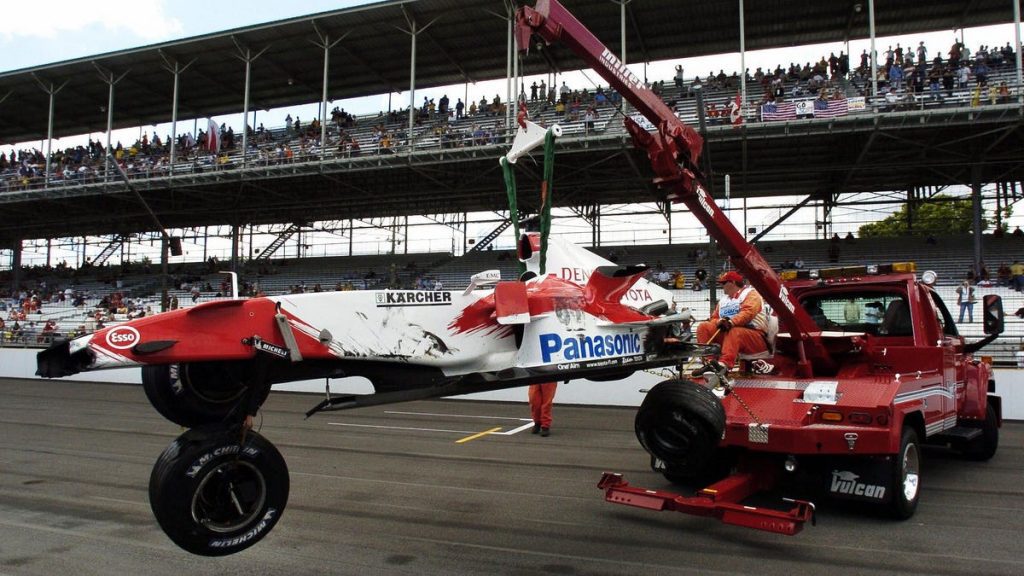Formula 1 in America Was Never the Same After 2005 United States Grand Prix

Workers collect Ralf Schumacher’s Toyota after it blew a left-rear tire at the 2005 US GP.Photo: STAN HONDA/AFP (Getty Images)
While Formula 1 doesn’t boast a long history of races so terrible that they turn an entire country off a certain kind of motorsport, one such race took place less than two decades ago at the 2005 United States Grand Prix. Unfortunately for F1, the politics-driven chaos was the antithesis of what American audiences needed after watching its own domestic series torn apart time and again by similar infighting.
This blog is part of a series on Formula 1’s presence in America. The sport has had a storied — but not particularly successful — history in the country. As F1 grows in America, and as we approach the 2022 United States Grand Prix, Jalopnik is taking a look back at the venues left in the dust and what ultimately led to their abandonment.
To say that America and F1 had grown jaded with one another after a decade of mediocre street races would perhaps be an understatement, but separation can be good for the soul. After nine years away, F1 recognized once again, that America was a significant untapped market, and it wanted in. This time, though, it opted against trying to control everything from circuit design to promotion, instead choosing to share those duties with the well-established folks at Indianapolis Motor Speedway.
In theory, hosting a Formula 1 race at America’s most iconic race track seemed like a no-brainer. The Indianapolis Motor Speedway did, after all, count toward the Grand Prix Championship for 10 years at the start of F1’s history, though no one ever made the overseas trek to take part. By converting the oval into a road course, the Speedway was able to firmly establish itself as the home of all American racing.
In 1998, Speedway President Tony George started discussions with F1 and kicked off a two-year renovation project to get the oval course up to F1 racing spec. That meant building a road course, updating the garage areas, and building a new facility for media and other communications. Overall, it seemed like a good idea.
G/O Media may get a commission
49% off
Cordless Leaf Blower
Leaves … leave now.
his lightweight but powerful motor runs on a rechargeable battery, and includes two tubes for maximum reach.
And the Speedway was immediately rewarded. The first U.S. Grand Prix at IMS took place in 2000, and it drew a massive crowd of over 200,000 paying fans — a massive change from the years of 20,000 fans in the stands. It became, at the time, the best-attended Grand Prix in F1 history.
Photo: STAN HONDA/AFP (Getty Images)
So, how did things go downhill? Well, while everyone remembers the 2005 U.S. Grand Prix for its chaos, the events at Indianapolis were regularly marred with controversy — and that’s not even taking into consideration the dark mood cast on the September 30 event in 2001 as a result of the September 11 attacks.
In 2002, for example, there were some finish-line shenanigans. Coming into the race, Michael Schumacher had already clinched the World Championship. But at the end of the event, he tried to stage a dead heat with his teammate Rubens Barrichello to complete a photo finish, celebrating another Schumacher win. However, Barrichello was considered the winner on the time charts, allegedly crossing the finish line 0.011 seconds ahead of the competition. Then, the wet-dry conditions at the 2003 event saw a tire battle between Bridgestone and Michelin that really didn’t leave anyone happy. In 2004, a start-line incident saw four cars retire from the race, along with two nasty accidents for Michelin-tired race cars.
And then came 2005. A perfect storm of factors led to what would ultimately become one of the worst races in F1 history. First, 2005 F1 rules forbade team from changing tires during a race. In addition, the IMS oval had been repaved for NASCAR. Further, the FIA adamantly refused to make any concessions for the struggling Michelin-shod teams.
Because of that, Michelin-shod teams suffered some significant crashes during the build-up to the race, and even replacement tires couldn’t solve any issues. Michelin representatives told the FIA that they couldn’t guarantee the safety of their tires for more than 10 laps. The FIA responded by claiming it was surprised F1 teams failed to arrive at an event with proper tires and refused to implement the recommended chicane ahead of Turn 13, which would have slowed the cars down and reduced the load on the tires.
There was significant back and forth between teams and the FIA, but as race day dawned, the tire problem remained. As a result, the Michelin-tired teams withdrew from the race, leaving three Bridgestone teams — six competitors in total — to contest the event. The estimated 100,000 spectators began to pour out of the grandstands after just 10 laps.
To call the race a farce might be too generous, in part because the FIA decided the race result would count toward the Championship, which was in direct contrast to previous races that had been run while teams were on strike.
But the worst part of it all was the fact that, aside from some refunds, nothing was done to reinvigorate the American fanbase. Instead, the politics of the situation soured many race fans, including those who hadn’t been at the track but who loved the sport.
If you showed up to the track expecting to see a serious battle and in return only received a measly race between a handful of cars, you would be irate, too — but the fans largely didn’t seem to be the concern. Instead, the Formula 1 circus struggled to look beyond its own paddock to comprehend the scope of what was happening, both at the track and within the entire American fanbase. The race at IMS lasted two more years before it joined the graveyard of failed American F1 venues.
Many of the people who talk about this race often from from an F1-focused, European perspective, so they often miss one crucial factor that really destroyed the morale of fans: American open-wheel racing was, perhaps, at its absolute lowest point in the early- to mid-2000s. These fans had already watched American open-wheel be ripped apart by internal politics, and as a result, an entire form of racing almost died. Worse still, the Indianapolis Motor Speedway had played host to some of the nastier battles of the IndyCar Split, especially regarding what cars from what breakout discipline were allowed to compete.
Formula 1 had a truly unprecedented opportunity in America at that time. It could have usurped competing American series to become the country’s favorite open-wheel sport. It could have sunk its teeth into a race-hungry American audience, which was turning more and more to NASCAR to fill its competitive needs.
Instead, fans showed up for a U.S. Grand Prix and watched a race be torn apart by politics yet again.
Formula 1 took a much-needed hiatus from America after the checkered flag flew on the 2007 United States Grand Prix. During that time period, the differing factions of American open-wheel reunited to begin the hard work of rebuilding a sport that had been tarnished with literal decades of controversy. NASCAR’s popularity began to decline, and motorsport in general began to fade from the public consciousness. Perhaps more importantly, F1 had a chance to reevaluate where it stood as a global phenomenon and actually plan a new attack at the American market.
The reintroduction of the United States Grand Prix at Circuit of the Americas wasn’t necessarily the sea-change moment that transformed America’s perspective on F1. The track was purpose-built for F1 and is essentially a cobbling together of some of F1’s greatest hits, transported to Austin, Texas.
But COTA is a first in U.S. Grand Prix history. It is the very first road course ever built for F1 racing. In Austin, F1 invested in the development of a long-term fanbase rather than trying to take a shortcut by, say, racing at tracks with already-established motorsport scenes or by forcing people to pay attention with a race in a city center. At COTA, F1 could write its own American story.





